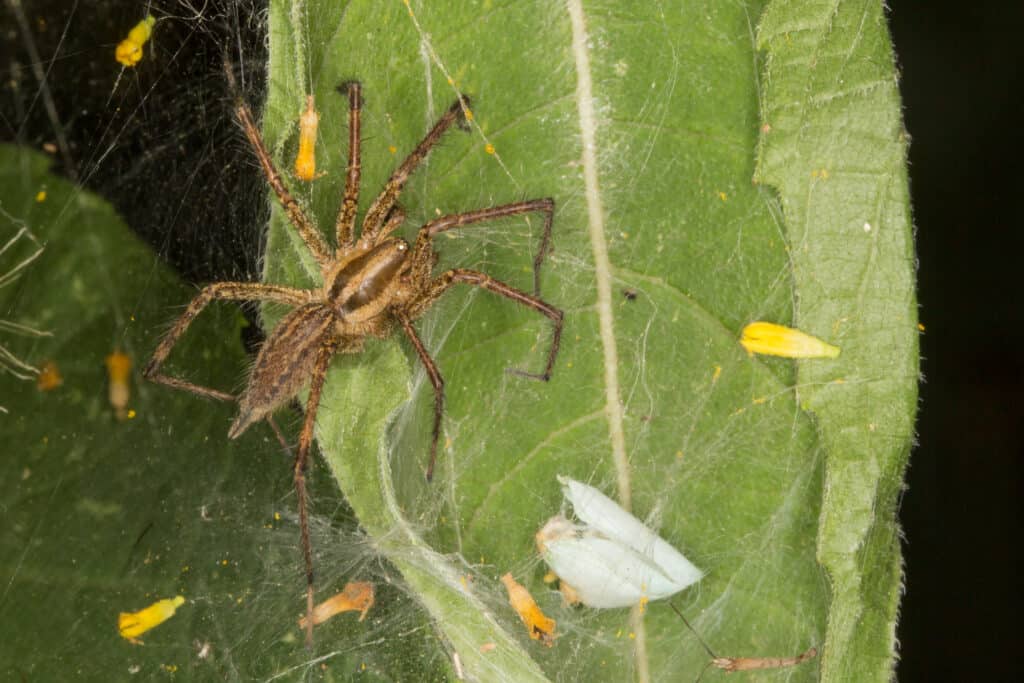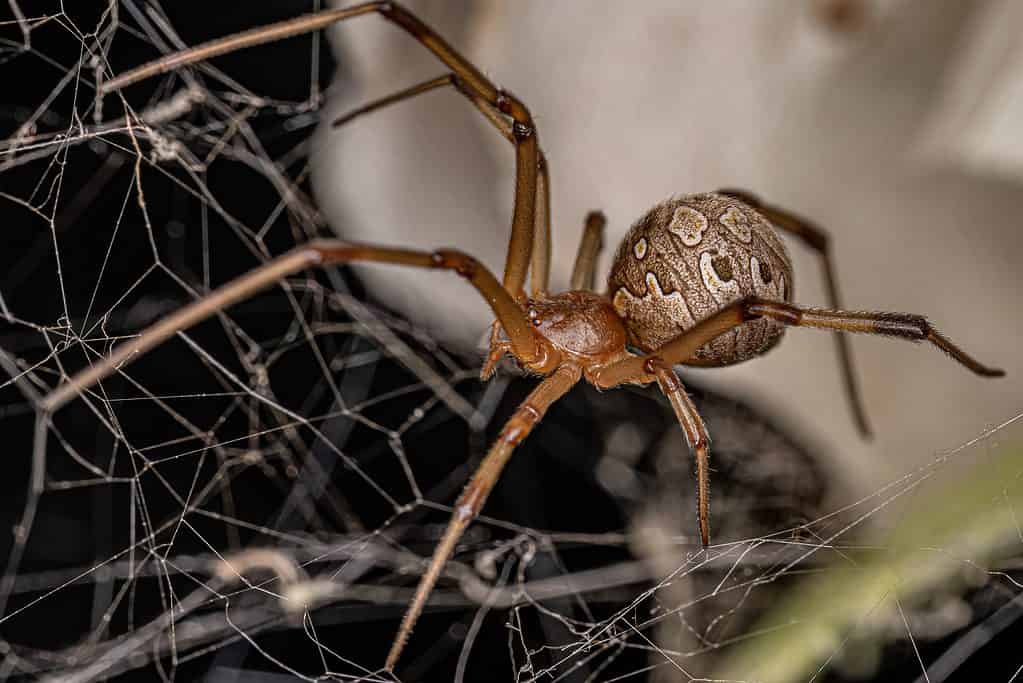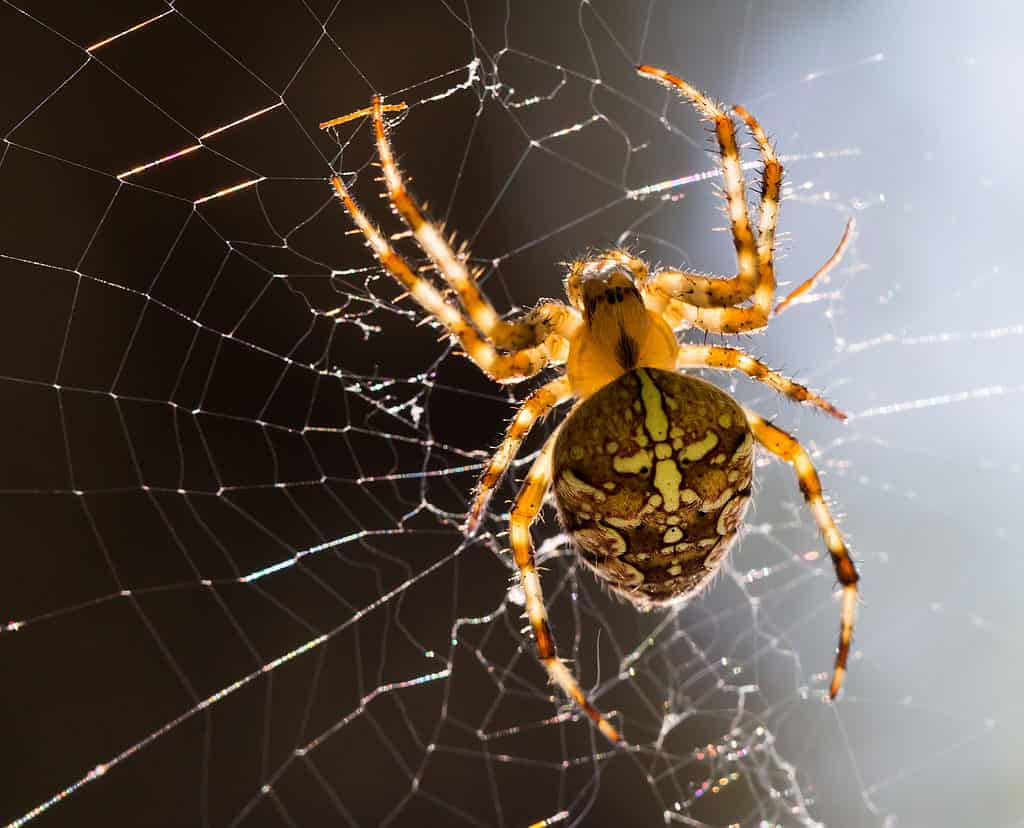Alabama is home to around 90 different species of spiders, and only eight of these spiders are considered venomous or potentially harmful. Spiders inhabit all parts of Alabama, including the south, central, and north part of the state where they can be found indoors mingling amongst humans, or distributed outdoors in diverse forests and outdoor habitats.
Spiders are found in all sorts of colors, but brown is a standard coloration that can be seen in many of the spiders found in Alabama. These spiders contribute to Alabama’s rich biodiversity, even though not all of the following spiders we mention in this article are native to Alabama.
Read on to learn about 7 brown spiders that can be found in Alabama.
Brown Recluse
The brown recluse (Loxosceles reclusa) is a small yet highly venous spider that is commonly found in the northern half of Alabama. This spider has a light to dark brown coloration and a small size of 0.23 to 0.75 inches.
The brown recluse is feared for their necrotic venom that usually needs medical attention if you were to get bitten. You can identify a brown recluse by the backward violin shaped marking that is located on their cephalothorax, and by their long legs that end in a sharp point.
The bite of a brown recluse is not very painful, and these spiders only bite to defend themselves. Like most spiders, the brown recluse will not pursue you just to bite you. You are most likely to get bitten if you accidentally disturb their webbing or harm the spider. These spiders will only bite you one time and not repeatedly, meaning they are not intentionally aggressive towards humans.
You can find the brown recluse both indoors or outdoors, where they prefer dark spaces such as under rocks, leaf litter, and piles of wood or tree branches. Here they will eat small insects inside of a nest.

The brown recluse spider can be identified by the backward violin shaped marking that is located on their cephalothorax.
©Nick626/Shutterstock.com
American Grass Spider
The American grass spider (Agelenopsis) is a genus of brown spiders that are commonly found throughout the United States, including Alabama. The genus consists of around 14 different species of Agelenopsis.
American grass spiders do not grow much larger than 0.7 inches. The male is typically smaller than the female, and female American grass spiders have a bulging abdomen as an adult.
American grass spiders have a brownish-yellow body with two distinctive dark lines on their cephalothorax, which is an indicative feature of this spider. As the spider’s name suggests, they can be found outdoors in grassy environments.
Although the American grass spider does have fangs, they are too small to penetrate a human’s skin, making them harmless to humans. Even if they were to bite you, the venom is not strong enough to harm you, and it is only deadly to their prey which includes small insects like termites and beetles.

American grass spiders have a brownish-yellow body with two distinctive dark lines on their cephalothorax.
©Elliotte Rusty Harold/Shutterstock.com
Starbellied Orbweaver
The starbellied orbweaver (Acanthepeira stellate) is a small spider with a fascinating appearance. The name “starbellied” comes from the spider’s star-shaped body that sets it apart from other spiders. The spider has up to 12 points on its abdomen, and the eyes are also located on a set of these points.
Starbellied orbweavers have brown bodies with various dark and light brown shades. The legs of this spider have distinctive bands that are lighter than the rest of the legs, and this spider only grows to around 0.19 to 0.59 inches. Male starbellied orbweavers are smaller than females, with females having a larger abdomen than males, which contributes to their bigger size.
They can be found in grasslands and meadows, and eat insects such as moths, flies, and wasps. The starbellied orbweaver does have venom that they use for their small prey, but it is not known to harm humans.

The Starbellied orbweaver (
Acanthepeira stellata) gets its name from its unique star-shaped body.
©Judy Gallagher, CC BY 2.0 <https://creativecommons.org/licenses/by/2.0>, via Wikimedia Commons – License
Brown Widow
As the name suggests, the brown widow (Latrodectus geometricus) is a brown spider that can be found in Alabama. It is one of the more venomous species of spiders, with an uncomfortable bite that is medically significant. However, the bite is slightly less potent than the bite of the black widow, a close relative.
Brown widow spiders grow to a size of 0.5 inches, making them fairly small. They have a brown body with various shades of light and dark brown creating a fascinating pattern. The legs of the brown widow have a set of dark brown bands which is a distinctive species for this spider.
You will find brown widow spiders in both outdoor and indoor environments, making webbing near houses, walls, and wooden fences. Brown widows will also web up vegetation and fallen tree branches.
When it comes to the brown widow’s diet, they feed on small insects such as woodlice and beetles, but they may also eat other small spiders.

The brown widow spider has a brown body with various shades of light and dark brown creating a distinctive pattern.
©Vinicius R. Souza/Shutterstock.com
Woodlouse Hunter Spider
The woodlouse hunter spider (Dysdera crocata) is known for having very large fangs (Chelicerata) that deliver a nasty bite that is described as painful and uncomfortable. Although their fangs are not dangerous to humans and other animals.
The woodlouse hunter preys on woodlice, hence their name but they can be aggressive and kill other spiders that they encounter.
Woodlouse hunter spiders reach a maximum size of 0.59 inches, while males are smaller at around 0.39 inches. They have a brownish-yellow color with a dark brown abdomen, and their exoskeleton has a glossy or waxy appearance.
You can find the woodlouse hunter spider underneath logs, rocks, fallen leaves, and even in backyards filled with wood. They prefer places that are warm and contain an abundance of woodlice.

The woodlouse hunter spider has a brownish-yellow color with a dark brown abdomen, and their exoskeleton has a glossy or waxy appearance.
©Macronatura.es/Shutterstock.com
European Garden Spider
The European garden spider or cross orbweaver (Araneus diadematus) is a popular spider that can be found in gardens, woodlands, savannas, and meadows with trees and shrubbery where they build their webs. They may also inhabit human homes with outdoor lighting, and web-up wooden beams or bushes that grow against walls.
European garden spiders are relatively small, growing to a size of 0.23 to 0.78 inches, with females being larger than males. These spiders have a distinctive cross on their abdomens that looks like a sword. The rest of their body is various shades of brown, with a prominent bulbous abdomen.
European garden spiders are unlikely to bite humans or animals unless they need to defend themselves, and their bite is mildly uncomfortable you might experience some swelling, but their venom is not harmful to humans. This spider eats a variety of small flying insects such as wasps and flies.

European garden spiders have a distinctive cross on their abdomens that looks like a sword.
©iStock.com/Iuliia Iunzhakova
Southeastern Wandering Spider
The southeastern wandering spider (Anahita punctulate) is a type of spider that prefers to live in burrows rather than spinning a web. They inhabit tropical climates like in Alabama and grow to an adult size of 1.5 inches, with males being smaller than females.
Southeastern wandering spiders have a light to dark brown coloration, with a pattern on their abdomen and cephalothorax. These spiders will ambush their prey, which consists of small insects.
The bite of a southeastern wandering spider can be a bit painful, but their venom is relatively harmless to humans. You may notice some redness and pain around the bite wound and they should not bite you unless they are trying to defend themselves.

The southeastern wandering spider prefers to live in burrows rather than spinning a web and will ambush their prey.
©Firdaus Khaled/Shutterstock.com
Up Next
The photo featured at the top of this post is © Ahturner/Shutterstock.com
Thank you for reading! Have some feedback for us? Contact the AZ Animals editorial team.






